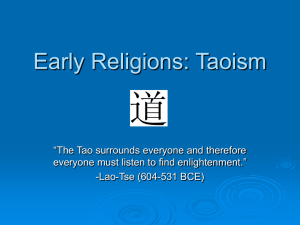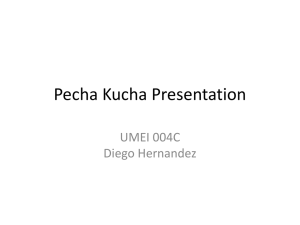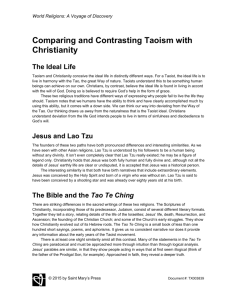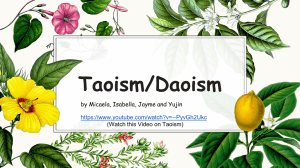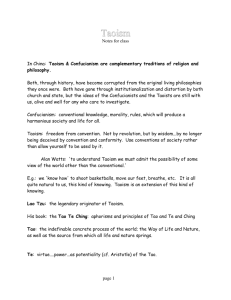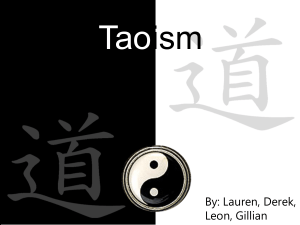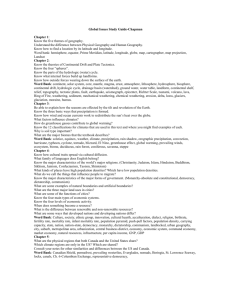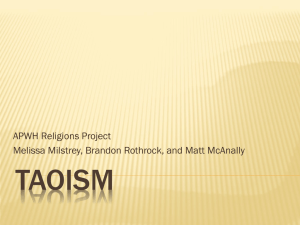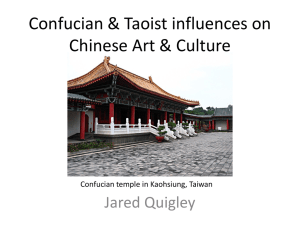Women in Taoism - Franklin College Faculty
advertisement
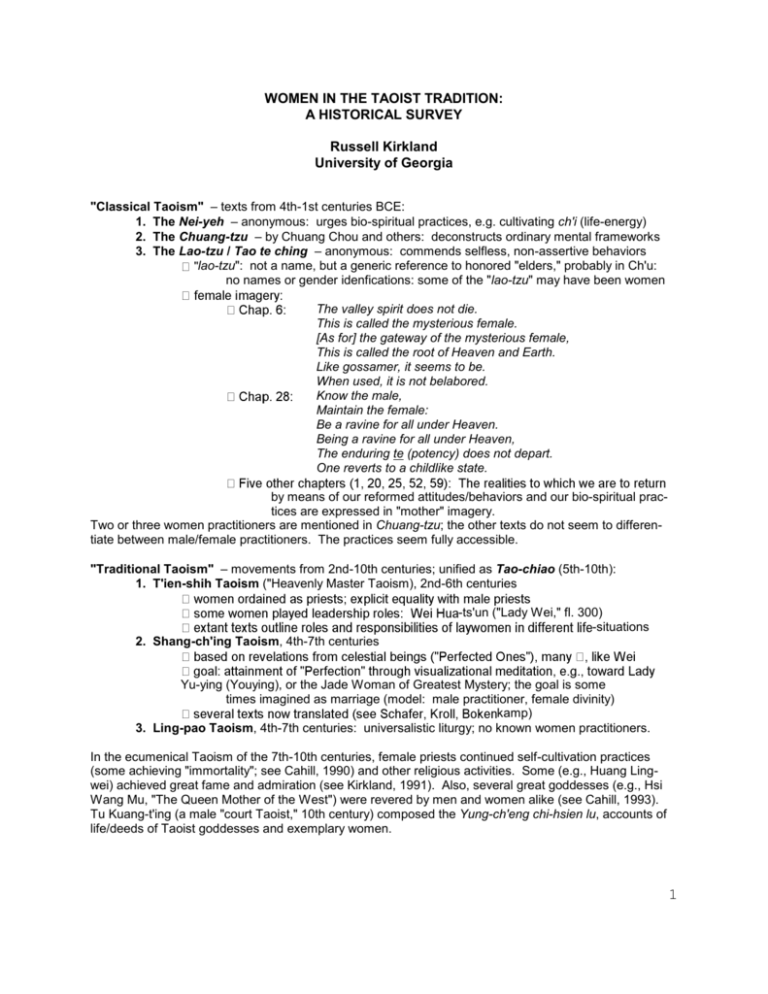
WOMEN IN THE TAOIST TRADITION: A HISTORICAL SURVEY Russell Kirkland University of Georgia "Classical Taoism" – texts from 4th-1st centuries BCE: 1. The Nei-yeh – anonymous: urges bio-spiritual practices, e.g. cultivating ch'i (life-energy) 2. The Chuang-tzu – by Chuang Chou and others: deconstructs ordinary mental frameworks 3. The Lao-tzu / Tao te ching – anonymous: commends selfless, non-assertive behaviors lao-tzu": not a name, but a generic reference to honored "elders," probably in Ch'u: no names or gender idenfications: some of the "lao-tzu" may have been women The valley spirit does not die. This is called the mysterious female. [As for] the gateway of the mysterious female, This is called the root of Heaven and Earth. Like gossamer, it seems to be. When used, it is not belabored. Know the male, Maintain the female: Be a ravine for all under Heaven. Being a ravine for all under Heaven, The enduring te (potency) does not depart. One reverts to a childlike state. by means of our reformed attitudes/behaviors and our bio-spiritual practices are expressed in "mother" imagery. Two or three women practitioners are mentioned in Chuang-tzu; the other texts do not seem to differentiate between male/female practitioners. The practices seem fully accessible. "Traditional Taoism" – movements from 2nd-10th centuries; unified as Tao-chiao (5th-10th): 1. T'ien-shih Taoism ("Heavenly Master Taoism), 2nd-6th centuries -ts'un ("Lady Wei," fl. 300) -situations 2. Shang-ch'ing Taoism, 4th-7th centuries Yu-ying (Youying), or the Jade Woman of Greatest Mystery; the goal is some times imagined as marriage (model: male practitioner, female divinity) kamp) 3. Ling-pao Taoism, 4th-7th centuries: universalistic liturgy; no known women practitioners. In the ecumenical Taoism of the 7th-10th centuries, female priests continued self-cultivation practices (some achieving "immortality"; see Cahill, 1990) and other religious activities. Some (e.g., Huang Lingwei) achieved great fame and admiration (see Kirkland, 1991). Also, several great goddesses (e.g., Hsi Wang Mu, "The Queen Mother of the West") were revered by men and women alike (see Cahill, 1993). Tu Kuang-t'ing (a male "court Taoist," 10th century) composed the Yung-ch'eng chi-hsien lu, accounts of life/deeds of Taoist goddesses and exemplary women. 1 "New Taoism" – movements from 10th-13th centuries; Cheng-i and Ch'üan-chen survive today 1. Ch'ing-wei Taoism: founded ca. 900 by Tsu Shu, a young woman; its therapeutic liturgies show "how closely Taoist practitioners came to link their physiological and mental well-being to spiritual enlightenment" (Boltz 1987); absorbed into Cheng-i. 2. Cheng-i Taoism: a sect of liturgical Taoism that flourished under imperial patronage from 11th to 18th centuries, and survives, mainly in Taiwan. Cheng-i priests maintain the universalistic liturgies of Ling-pao Taoism, and also per form rituals of exorcism and personal protection. Unlike the aristocratic traditions of "Traditional Taoism, Cheng-i has always appealed to the masses, but has never allowed women full ordination or leadership. 3. Ch'üan-chen Taoism: founded by Wang Che (Wang Ch'ung-yang), a 12th-century scholar who taught that immortality can be attained in this life by cultivating one's internal spiritual realities (hsing) and har monizing them with one's external life (ming). His seven famous disciples included a woman, Sun Pu-erh (see Boltz 1987, Wong 1991). The tradition soon adopted a monastic setting, and its teachings became a spiritualized re-interpretation of the older Taoist practices known as "inner alchemy." Ch'üan-chen Taoism paralleled – and interacted with – the meditative tradi tions of Ch'an Buddhism and Neo-Confucianism: all three stress individual moral and spiritual discipline. Ch'üan-chen endures today, both intellectually and institutionally, though it is largely unknown to Westerners, and has attracted little attention from Western scholars. From the earliest days of the tradition, women have been active, and regarded as equals by male participants. Women today continue to play such roles at Ch'üan-chen temples in China. SEE FURTHER: 1. Russell Kirkland, Taoism: The Enduring Tradition (London and New York: Routledge, 2004), 126-144 See http://rels.queensu.ca/dao/newbooks.php 2. Catherine Despeux and Livia Kohn, Women in Daoism (Boston: Three Pines Press, 2003) See http://www.threepinespress.com/books.women.php 3. Livia Kohn, “Are Women in Daoism Different from Women in Chinese Society?” At http://rels.queensu.ca/dao/papers.kohn.php 4. Abstracts of Papers on “Women in Taoism” delivered at the 2003 conference on “Daoism and the Contemporary World”: a. Chao Shinyi, “The Perfection of Daoist Priestesses during the Song-Yuan Period”; and b. Ho Wan-li, “Daoist Nuns in Contemporary Taiwan” At http://rels.queensu.ca/dao/daoismconf.abstracts.php. 5. All Publications by Suzanne Cahill, including her new book: Divine Secrets of the Daoist Sisterhood: Du Guangting's "Record of the Assembled Transcendents of the Fortified Walled City." A thematic presentation of the lives of medieval women Daoists, based on-and with ample translations from Du Guangting's collection of the lives of female immortals. Presents the key goddesses of the Daoist religion together with numerous ordinary women, who left their families and followed the lure of the Dao. (From http://www.threepinespress.com/index.titles.php) 2 3
